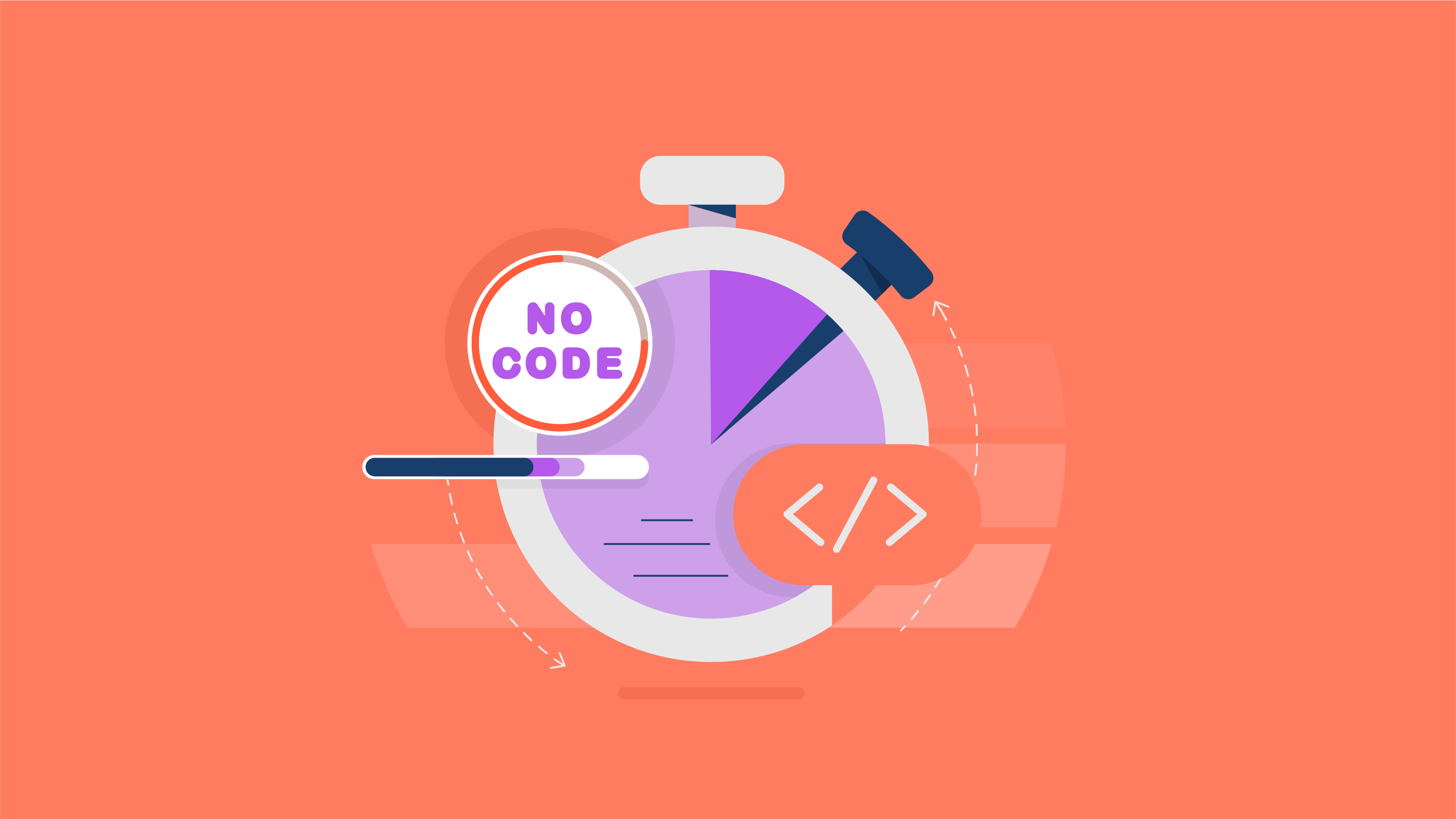The demand for fast and efficient software solutions has only grown over the years. More and more businesses are digitalizing and, accordingly, need applications that would make their operational activities optimized and customer service more successful. So companies need different products, from mobile applications that revolutionize the way they communicate to web platforms that change the way they do business.
However, traditional software development methods are not always the right solution. They rely on complex coding languages and specialized expertise, often creating barriers to entry for individuals and organizations seeking to bring their ideas to life. And if earlier app development required a lot of time and effort, today’s approach is gradually changing. This is where the no-code approach comes into the picture.
Low-code and no-code platforms have brought a paradigm shift in software development, offering streamlined and affordable alternatives to traditional coding approaches. In our new article, we will consider the principles of this approach, as well as its advantages, problems, and practical applications.
What Is No-Code Development?
No-code development, in general, is about a paradigm shift in software creation. Traditionally, the ability to develop websites and applications was limited to those who were fluent in programming languages and had coding skills.
However, no-code tools have eliminated this barrier, allowing people without coding experience to create complex software using an intuitive UI and no-code development platform.
How do no-code tools work?
No-code development involves building software, including websites and mobile apps, using drag-and-drop visual interfaces, eliminating the need for manual coding.
Visual drag-and-drop interfaces serve as the cornerstone of codeless development, bridging the gap between programmers and non-programmers. They enable people to realize their entrepreneurial aspirations, optimize business operations, and automate work processes without having to deal with complex lines of code.
It is important to note that despite its name, no-code development does not criticize the role of coding. It’s more about simplifying development by using the expertise of an engineer who develops a no-code app builder. Many professionals are adopting no-coding themselves to optimize resource allocation for mission-critical projects or as a break from the rigors of traditional coding.
A new environment for ideas
Such democratization allows almost anyone to materialize their ideas on the Internet regardless of technical level. People with innovative concepts can realize their visions without technical difficulties or financial constraints.
The proliferation of no-code tools and applications has revolutionized the field, allowing people to bring their ideas to life with unprecedented ease. This paradigm shift applies not only to entrepreneurs and non-technical founders but also to businesses in various industries, from healthcare product development to e-commerce.
What Is Low-Code Software Development?
The nuances between low-code platforms and no-code technology are everything. Although these terms often overlap, they outline different approaches to app development and writing code, primarily in terms of functionality and ease of use.
No-code platforms typically cater to people without programming experience and require minimal coding or app design knowledge. They are characterized by their simplicity, which allows users to quickly create basic mobile or web applications without delving into complex lines of code.
On the other hand, low-code platforms are slightly more detailed, including coding elements in their visual modeling environments. However, they still prefer ease of use. Low-code tools allow people who can write code to add custom functions or perform more complex tasks. This flexibility allows for better customization and control of the final product.
How does it work?
Both low-code and no-code platforms derive from earlier rapid application development initiatives using object-oriented programming languages like C++ and Java. However, they represent evolutionary steps in the democratization of software development, catering to a broader audience with varying levels of technical prowess.
The distinction between these concepts can sometimes be blurred. However, understanding their unique attributes is critical to choosing the most suitable platform for your software projects. You may prefer simplicity and ease of use, or you may require greater customization and integration capabilities. Both no-code development and low-code offer valuable tools to bring your ideas to life.
Who can use low-code tools?
Low-code platforms often have excellent integration capabilities with legacy applications, making them a better choice for enterprises looking to modernize their systems. In addition, they offer robust development, testing, and extensibility features, which is essential for IT professionals and developers looking to simplify workflows and increase productivity.
On the contrary, despite no-code technology being characterized by simplicity and accessibility, there are certain limitations. For example, when it comes to integrating with existing systems or performing more complex tasks.
No-code technologies are ideal for individuals or small businesses looking to quickly prototype ideas or launch basic web projects without the need for advanced programming knowledge. However, this will not be a good solution for organizations with complex infrastructures. Here, you need software development skills and high-quality UX design.
Key takeaways:
- The no-code approach is a paradigm shift that eliminates coding needs.
- It uses an intuitive UI and platform and democratizes software development.
- It includes drag-and-drop interfaces and no manual coding.
- Bridges the gap between programmers and non-programmers.
- Low-code software development is different from no-code and includes coding.
- Offers better customization and control.
- Its functionality is derived from rapid app development.
- It caters to a broader audience with varying technical levels.
- It is perfect for enterprises modernizing systems.
- It offers integration with legacy applications and is suitable for IT professionals and developers.
Ready to explore how low-code and no-code platforms can revolutionize your app development process while reducing costs? Contact us today for a personalized consultation tailored to your business needs.
Main Advantages of Low-Code and No-Code Platforms

There are many compelling reasons why individuals and companies choose code-free development over traditional coding or other options. Of course, there are additional benefits to such approaches for each individual business. Although motivations may vary, several common characteristics underlie the decision to adopt no-code tools.
- Cost reduction
writing code from scratch is always expensive. You need to find a specialist with a certain set of knowledge and skills, with specific experience in a certain technology stack or industry. Of course, in many cases, this is a justified expense and how much it costs to develop a mobile application may not matter if you are creating a unique and complex product.
However, there is another solution for more straightforward solutions. One of the most important advantages of each no-code development platform is its economic efficiency. It empowers people to design and build their own products without having to hire developers or spend significant time learning coding languages.
No-code tools are a budget alternative to traditional development methods. They are ideal for companies with limited financial resources to innovate and thrive.
- Speed and efficiency
no code app builder is about prioritizing fast development and abstracting from the complexity of coding. Users can create simple products quickly and efficiently. This option will be ideal if you do not need overly complex functionality and severe security measures. It will significantly shorten and simplify the entire process of creating a product.
- Accessibility and inclusiveness
traditional development without software code has certain barriers to entry. People can have different experiences and skill sets, but they can all use no code app builder. Whether you’re a creative enthusiast, a hobbyist, or a budding entrepreneur, no-code enables you to turn your ideas into real products.
All you need is a laptop and an internet connection. Development becomes accessible to anyone with a vision and a desire to learn.
- Simplicity and convenience
No-code platforms have an intuitive user interface. It is designed specifically for non-programmers.
With minimal or no training, users can navigate the development process effortlessly. This is possible thanks to drag-and-drop functionality and pre-designed templates for easy app creation. This simplicity not only speeds up the development cycle but also encourages creativity and innovation among users who may have previously felt excluded from the programming world.
- Mitigating Shadow IT
This approach reduces the risk of shadow IT by providing users with predefined settings and tools authorized by the organization. Business users can satisfy their needs in a controlled environment, reducing the likelihood of unauthorized software use. This, in turn, increases security and optimizes IT management processes.
Low-code benefits
The low-code approach offers many attractive advantages for both web and mobile app development. Let’s take a look at some of them.
- Productivity improvement. This approach allows you to focus on high-value tasks rather than spending time on repetitive coding activities. Automation of everyday coding tasks and reusable components improves developer productivity.
- Flexibility and customization. Such platforms offer a high degree of flexibility and customization. Developers can add custom code as needed, allowing them to meet specific business requirements and create custom solutions. This flexibility ensures that low-code applications can adapt to unique use cases and changing business needs. It also guarantees a high efficiency of UX.
- Improved maintenance and scalability. Such products are usually easier to maintain and scale compared to traditional code-based applications. The modular nature of low-code development allows for easy upgrades and modifications, minimizing downtime and reducing the risk of bugs. In addition, such platforms often provide built-in scalability features that allow applications to handle increased user load and growing data volumes without sacrificing performance.
- Bridging the skills gap. This approach lowers the barriers for people interested in software development by abstracting away complex coding concepts. It allows developers and business users with limited technical knowledge to participate in the application development process.
- Integration with legacy systems. As already mentioned, low-code solutions have strong integration capabilities, allowing developers to easily connect new applications to existing legacy systems and third-party services.
The low-code approach in app development is about simplifying writing code and expanding the possibilities of your software.
Key takeaways
- Advantages of the no-code approach: cost reduction (perfect for companies with limited financial resources), speed and efficiency, accessibility and inclusiveness, simplicity and convenience.
- It prioritizes fast development and abstraction from coding complexity.
- It is perfect for simple products without overly complex functionality.
- Reduces risk of unauthorized software use.
- Advantages of low-code approach: productivity improvement, flexibility and customization, improved maintenance and scalability, bridging the skills gap, integration with legacy systems.
- Automation and reusable components enhance developer productivity.
- Allows for easy adaptation to unique use cases and changing needs.
- The modular nature allows for easy upgrades and modifications.
- Lowers barriers for people with limited technical knowledge.
Where Is The Catch?
Low-code and no-code development have some disadvantages that organizations should consider. Let’s take a closer look at them.
Disadvantages of no-code development
No-code platforms prioritize simplicity and ease of use over extensive customization options. As a result, users may experience limitations when trying to implement custom-designed or complex features.
Additionally, this approach locks you into specific platform vendors, limiting flexibility and potentially leading to vendor lock-in. If the platform provider ends support or raises prices, you may face problems migrating your applications to alternative solutions.
It’s also worth understanding that no-code apps can be difficult to scale effectively as the application’s complexity increases or user demand grows. While they are suitable for simple projects or prototypes, they may lack the reliability and performance needed for large-scale enterprise applications.
Additionally, it cannot be overlooked that no-code solutions create security risks related to data privacy, compliance, and vulnerability to cyber-attacks. Because of the simplified nature of the development process, users may inadvertently expose sensitive information or overlook security best practices.
Finally, integrating no-code tools with existing third-party systems or services can be difficult. Such products do not offer comprehensive integration capabilities, which limits interoperability and prevents seamless data exchange between different systems.
Pitfalls of low-code development
Low code has slightly different pitfalls than no-code platforms.
First, while low-code solutions abstract away much of the coding complexity, they still require users to learn concepts and workflows. Especially those related to a specific platform and mobile apps. Developers may face a learning curve when transitioning to a new low-code environment or mastering advanced features.
The low-code approach enables users to add their own code to extend the platform’s capabilities or implement complex functions. However, excessive use of custom code can lead to code overload, reduced application performance, and increased maintenance overhead. This can also cause potential reliability issues.
Rapid developments using both no-code and low-code tools can lead to the accumulation of technical debt. This could be suboptimal design choices, code duplication, and cuts taken to meet project deadlines.
Over time, technical debt can hinder future development efforts and increase the cost of maintaining and developing applications. In this case, you should turn to professional mobile application developers.
Similar to no-code development, a low-code approach locks users into specific platform vendors, potentially limiting flexibility and exposing organizations to the risks of vendor lock-in.
Additionally, while such solutions simplify routine development tasks, they can be difficult to adapt to highly complex or specialized use cases. Developers may need help with implementing advanced algorithms, complex business logic, or performance-critical features.
Looking for a trusted partner to guide you through your digital transformation journey? Let’s explore collaboration opportunities and work together to unlock new possibilities for your business with low-code and no-code technologies.
What Can You Build With No-Code Tools?

No-code development is a way to create an easy-to-use and manual product fairly quickly and efficiently. We will look at a few practical examples, but there are actually many of them. Let’s look at the most common options.
- Web programs. You can create interactive web applications for a variety of purposes, such as shopping, restaurant reservations, virtual real estate tours, and more. These will be simple and effective web solutions without complex functionality but with everything necessary for a high-quality user experience.
- Mobile applications. This technology can also be used to develop mobile applications. Most often, for such purposes, developers use such platforms as Glide, Adalo and Universe. However, you can choose any tool that is convenient for you to easily design and build mobile apps without writing code.
- Apps for back office. You can streamline business operations with back-office applications for tasks such as processing invoices and monitoring key performance indicators.
- Prototypes and MVPs. With such tools, you can quickly prototype your ideas and create minimum viable products (MVPs). This helps test concepts, gather user feedback, and test market demand before investing in full-scale development.
- Workflow management. With a no-code approach, you can implement workflow management systems to automate processes. It can also be simple software for setting internal service level agreements and tracking tasks.
- Chatbots and virtual assistants. It’s also a great way to build chatbots and virtual assistants to automate customer support, answer common questions, and help users with tasks using natural language processing (NLP) and predefined workflows.
- Forms and surveys. Developers use such technology to create special forms and surveys to collect feedback, collect information from users, and optimize data collection processes for various purposes. This can be lead generation, market research, and event registration.
- Internal tools and utilities. You can quickly and easily develop special tools and utilities to solve specific business needs and improve internal processes. These can be employee registration portals, project management dashboards, and resource allocation tools.
- Applications for human resources. It can be a great solution for developing simple and effective personnel management systems. You can create applications for employee onboarding, leave requests, performance evaluations, and more.
- Registration and event management. Such solutions are useful for the rapid development of online registration forms, ticketing systems, and event management platforms. In other words, for everything that helps to effectively organize and manage events, conferences, seminars, and webinars.
Also, the no-code approach can be useful for developing online communities, discussion forums, social networking platforms, etc.
Wrapping Up
The emergence of low-code and no-code platforms is an effective way of digital transformation and a tool for significant cost reduction. It’s about democratizing and simplifying the process of developing digital products, making it accessible and speeding up the process. While traditional development methods require specialized experience, the new approach is about the fact that everyone can implement their ideas or at least create a prototype.
These aren’t just new tools; they have sparked a revolution – a paradigm shift in how we design, build, and deploy software solutions. By democratizing app development, they broke down age barriers. From aspiring entrepreneurs with a grand vision to seasoned professionals looking to streamline workflows, the accessibility and inclusiveness of low-code and no-code development have opened doors that were previously thought to be closed.
However, despite the appeal of speed and simplicity, we must not lose sight of the challenges. Scalability, security, and technical debt are emerging as major obstacles to digital transformation. It is imperative to navigate these challenges carefully and be aware of the risks involved. The main helper in this is a culture of continuous learning, innovation, and collaboration, as well as the use of the experience of consultants with sufficient expertise.
We at Cadabra Studio have experience in both traditional approaches and using low-code or no-code tools. We will be happy to help you use this innovative approach and get the most benefits for your business. Let’s talk.











